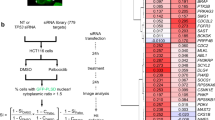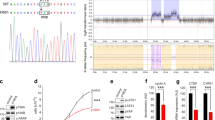Abstract
The epithelial cell adhesion molecule (EpCAM) is an integral transmembrane protein that is frequently overexpressed in embryonic stem cells, tissue progenitors, carcinomas and cancer-initiating cells. In cancer cells, expression of EpCAM is associated with enhanced proliferation and upregulation of target genes including c-myc. However, the exact molecular mechanisms underlying the observed EpCAM-dependent cell proliferation remained unexplored. Here, we show that EpCAM directly affects cell cycle progression via its capacity to regulate the expression of cyclin D1 at the transcriptional level and depending on the direct interaction partner FHL2 (four-and-a-half LIM domains protein 2). As a result, downstream events such as phosphorylation of the retinoblastoma protein (Rb) and expression of cyclins E and A are similarly affected. In vivo, EpCAM expression strength and pattern are both positively correlated with the proliferation marker Ki67, high expression and nuclear localisation of cyclin D1, and Rb phosphorylation. Thus, EpCAM enhances cell cycle progression via the classical cyclin-regulated pathway.
This is a preview of subscription content, access via your institution
Access options
Subscribe to this journal
Receive 50 print issues and online access
$259.00 per year
only $5.18 per issue
Buy this article
- Purchase on Springer Link
- Instant access to full article PDF
Prices may be subject to local taxes which are calculated during checkout






Similar content being viewed by others
References
Munz M, Baeuerle PA, Gires O . The emerging role of EpCAM in cancer and stem cell signaling. Cancer Res 2009; 69: 5627–5629.
Balzar M, Winter MJ, de Boer CJ, Litvinov SV . The biology of the 17-1A antigen (Ep-CAM). J Mol Med 1999; 77: 699–712.
Went P, Vasei M, Bubendorf L, Terracciano L, Tornillo L, Riede U et al. Frequent high-level expression of the immunotherapeutic target Ep-CAM in colon, stomach, prostate and lung cancers. Br J Cancer 2006; 94: 128–135.
Visvader JE, Lindeman GJ . Cancer stem cells in solid tumours: accumulating evidence and unresolved questions. Nat Rev Cancer 2008; 8: 755–768.
Gires O, Klein CA, Baeuerle PA . On the abundance of EpCAM on cancer stem cells. Nat Rev Cancer 2009; 9: 143 author reply 143.
Ng VY, Ang SN, Chan JX, Choo AB . Characterization of epithelial cell adhesion molecule as a surface marker on undifferentiated human embryonic stem cells. Stem Cells 2009; 28: 29–35.
Gonzalez B, Denzel S, Mack B, Conrad M, Gires O . EpCAM is involved in maintenance of the murine embryonic stem cell phenotype. Stem Cells 2009; 27: 1782–1791.
Lu TY, Lu RM, Liao MY, Yu J, Chung CH, Kao CF et al. Epithelial cell adhesion molecule regulation is associated with the maintenance of the undifferentiated phenotype of human embryonic stem cells. J Biol Chem 2010; 285: 8719–8732.
Denzel S, Maetzel D, Mack B, Eggert C, Barr G, Gires O . Initial activation of EpCAM cleavage via cell-to-cell contact. BMC Cancer 2009; 9: 402.
Maetzel D, Denzel S, Mack B, Canis M, Went P, Benk M et al. Nuclear signalling by tumour-associated antigen EpCAM. Nat Cell Biol 2009; 11: 162–171.
Chen HF, Chuang CY, Lee WC, Huang HP, Wu HC, Ho HN et al. Surface marker epithelial cell adhesion molecule and E-cadherin facilitate the identification and selection of induced pluripotent stem cells. Stem Cell Rev 2011; 7: 722–735.
Huang HP, Chen PH, Yu CY, Chuang CY, Stone L, Hsiao WC et al. Epithelial cell adhesion molecule (EpCAM) complex proteins promote transcription factor-mediated pluripotency reprogramming. J Biol Chem 2011; 286: 33520–33532.
Maaser K, Borlak J . A genome-wide expression analysis identifies a network of EpCAM-induced cell cycle regulators. Br J Cancer 2008; 99: 1635–1643.
Munz M, Kieu C, Mack B, Schmitt B, Zeidler R, Gires O . The carcinoma-associated antigen EpCAM upregulates c-myc and induces cell proliferation. Oncogene 2004; 23: 5748–5758.
Shtutman M, Zhurinsky J, Simcha I, Albanese C, D’Amico M, Pestell R et al. The cyclin D1 gene is a target of the beta-catenin/LEF-1 pathway. Proc Natl Acad Sci USA 1999; 96: 5522–5527.
Weinberg RA . The retinoblastoma protein and cell cycle control. Cell 1995; 81: 323–330.
Mittnacht S . Control of pRB phosphorylation. Curr Opin Genet Dev 1998; 8: 21–27.
Geng Y, Yu Q, Sicinska E, Das M, Bronson RT, Sicinski P . Deletion of the p27Kip1 gene restores normal development in cyclin D1-deficient mice. Proc Natl Acad Sci USA 2001; 98: 194–199.
Litvinov SV, van Driel W, van Rhijn CM, Bakker HA, van Krieken H, Fleuren GJ et al. Expression of Ep-CAM in cervical squamous epithelia correlates with an increased proliferation and the disappearance of markers for terminal differentiation. Am J Pathol 1996; 148: 865–875.
Schon MP, Schon M, Klein CE, Blume U, Bisson S, Orfanos CE . Carcinoma-associated 38-kD membrane glycoprotein MH 99/KS 1/4 is related to proliferation and age of transformed epithelial cell lines. J Invest Dermatol 1994; 102: 987–991.
Osta WA, Chen Y, Mikhitarian K, Mitas M, Salem M, Hannun YA et al. EpCAM is overexpressed in breast cancer and is a potential target for breast cancer gene therapy. Cancer Res 2004; 64: 5818–5824.
Munz M, Hofmann T, Scheibe B, Gange M, Junghanns K, Zeidler R et al. The carcinoma-associated antigen EpCAM induces glyoxalase 1 resulting in enhanced methylglyoxal turnover. Cancer Genomics Proteomics 2004; 1: 241–247.
Johannessen M, Moller S, Hansen T, Moens U, Van Ghelue M . The multifunctional roles of the four-and-a-half-LIM only protein FHL2. Cell Mol Life Sci 2006; 63: 268–284.
Labalette C, Nouet Y, Sobczak-Thepot J, Armengol C, Levillayer F, Gendron MC et al. The LIM-only protein FHL2 regulates cyclin D1 expression and cell proliferation. J Biol Chem 2008; 283: 15201–15208.
Guo Z, Zhang W, Xia G, Niu L, Zhang Y, Wang X et al. Sp1 upregulates the four and half lim 2 (FHL2) expression in gastrointestinal cancers through transcription regulation. Mol Carcinog 2010; 49: 826–836.
Spizzo G, Went P, Dirnhofer S, Obrist P, Moch H, Baeuerle PA et al. Overexpression of epithelial cell adhesion molecule (Ep-CAM) is an independent prognostic marker for reduced survival of patients with epithelial ovarian cancer. Gynecol Oncol 2006; 103: 483–488.
Gabriel B, Fischer DC, Orlowska-Volk M, zur Hausen A, Schule R, Muller JM et al. Expression of the transcriptional coregulator FHL2 in human breast cancer: a clinicopathologic study. J Soc Gynecol Investig 2006; 13: 69–75.
Gabriel B, Mildenberger S, Weisser CW, Metzger E, Gitsch G, Schule R et al. Focal adhesion kinase interacts with the transcriptional coactivator FHL2 and both are overexpressed in epithelial ovarian cancer. Anticancer Res 2004; 24: 921–927.
Ng CF, Zhou WJ, Ng PK, Li MS, Ng YK, Lai PB et al. Characterization of human FHL2 transcript variants and gene expression regulation in hepatocellular carcinoma. Gene 2011; 481: 41–47.
Yamashita T, Forgues M, Wang W, Kim JW, Ye Q, Jia H et al. EpCAM and alpha-fetoprotein expression defines novel prognostic subtypes of hepatocellular carcinoma. Cancer Res 2008; 68: 1451–1461.
Soucek T, Pusch O, Hengstschlager-Ottnad E, Adams PD, Hengstschlager M . Deregulated expression of E2F-1 induces cyclin A- and E-associated kinase activities independently from cell cycle position. Oncogene 1997; 14: 2251–2257.
Schulze A, Zerfass K, Spitkovsky D, Middendorp S, Berges J, Helin K et al. Cell cycle regulation of the cyclin A gene promoter is mediated by a variant E2F site. Proc Natl Acad Sci USA 1995; 92: 11264–11268.
Jansen-Durr P, Meichle A, Steiner P, Pagano M, Finke K, Botz J et al. Differential modulation of cyclin gene expression by MYC. Proc Natl Acad Sci USA 1993; 90: 3685–3689.
Yamashita T, Budhu A, Forgues M, Wang XW . Activation of hepatic stem cell marker EpCAM by Wnt-beta-catenin signaling in hepatocellular carcinoma. Cancer Res 2007; 67: 10831–10839.
Sankpal NV, Willman MW, Fleming TP, Mayfield JD, Gillanders WE . Transcriptional repression of epithelial cell adhesion molecule contributes to p53 control of breast cancer invasion. Cancer Res 2009; 69: 753–757.
Nasr AF, Nutini M, Palombo B, Guerra E, Alberti S . Mutations of TP53 induce loss of DNA methylation and amplification of the TROP1 gene. Oncogene 2003; 22: 1668–1677.
Lin T, Chao C, Saito S, Mazur SJ, Murphy ME, Appella E et al. p53 induces differentiation of mouse embryonic stem cells by suppressing Nanog expression. Nat Cell Biol 2005; 7: 165–171.
Michalides R, van Veelen N, Hart A, Loftus B, Wientjens E, Balm A . Overexpression of cyclin D1 correlates with recurrence in a group of forty-seven operable squamous cell carcinomas of the head and neck. Cancer Res 1995; 55: 975–978.
Martin B, Schneider R, Janetzky S, Waibler Z, Pandur P, Kuhl M et al. The LIM-only protein FHL2 interacts with beta-catenin and promotes differentiation of mouse myoblasts. J Cell Biol 2002; 159: 113–122.
Yanamoto S, Kawasaki G, Yoshitomi I, Iwamoto T, Hirata K, Mizuno A . Clinicopathologic significance of EpCAM expression in squamous cell carcinoma of the tongue and its possibility as a potential target for tongue cancer gene therapy. Oral Oncol 2007; 43: 869–877.
Author information
Authors and Affiliations
Corresponding author
Ethics declarations
Competing interests
The authors declare no conflict of interest.
Additional information
Supplementary Information accompanies the paper on the Oncogene website
Rights and permissions
About this article
Cite this article
Chaves-Pérez, A., Mack, B., Maetzel, D. et al. EpCAM regulates cell cycle progression via control of cyclin D1 expression. Oncogene 32, 641–650 (2013). https://doi.org/10.1038/onc.2012.75
Received:
Revised:
Accepted:
Published:
Issue Date:
DOI: https://doi.org/10.1038/onc.2012.75
Keywords
This article is cited by
-
Machine-learning-based classification of diffuse large B-cell lymphoma patients by a 7-mRNA signature enriched with immune infiltration and cell cycle
Clinical and Translational Oncology (2023)
-
Understanding the versatile roles and applications of EpCAM in cancers: from bench to bedside
Experimental Hematology & Oncology (2022)
-
Absence of EpCAM in cervical cancer cells is involved in slug induced epithelial-mesenchymal transition
Cancer Cell International (2021)
-
Advances in Liver Cancer Stem Cell Isolation and their Characterization
Stem Cell Reviews and Reports (2021)
-
The plasticity of pancreatic cancer stem cells: implications in therapeutic resistance
Cancer and Metastasis Reviews (2021)



